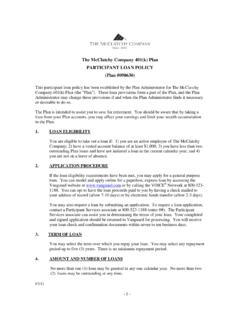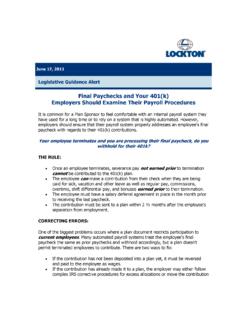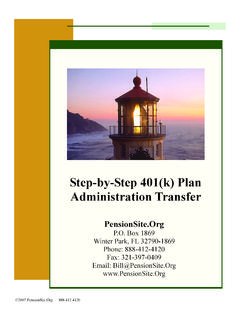Transcription of Frequently Asked Questions About Profit Sharing …
1 From the Profit Sharing /401(k) Council of America ( ) Frequently Asked Questions About Profit Sharing and 401(k) Plans1. How much money can I put into my 401(k) account?The maximum pre-tax contribution dollar amount is set by law and adjusted for inflation annually. The 2004 pre-tax contribution limit is $13,000. If you are age 50 or older you may also make an additional catch-up contribution of $3,000 per year. Some plans may offer you the option to contribute on an after-tax basis which is not included in the $13,000 limit. Note that plans may restrict employee contributions to an amount less than $13,000, and may also choose not to permit catch-up contributions. In addition, there are special non-discrimination rules to prevent highly compensated employees (HCE) from being able to save substantially more than lower paid employees. If you earn more than $90,000 a year, or own 5 percent or more of the company , additional contribution caps may apply for What is the difference between investing pre-tax and after-tax contributions?
2 The difference between the two types of contributions is when you are taxed. Pre-tax contributions and earnings are taxed only when you withdraw it. Since the money that would normally be paid in taxes goes directly into the plan, pre-tax contributions can accumulate quickly. However, if you need to withdraw money prior to age 59 you may incur a 10% withdraw penalty, in addition to owing current income taxes. After-tax contributions are taxed before they are put into the plan. Although you won t owe taxes on your contributions when you take a withdrawal, you will be taxed on the earnings and may be subject to an early withdrawal penalty on the interest earned if you do so before age 59 .3. What pre-tax percentage should I invest when I am starting out?Any savings is better than nothing and the sooner you get started, the better!! You should maximize your company s match. For example, if your company matches 50 cents on the dollar up to 6%, you should contribute at least 6%.
3 Simply defer as much as you can afford to budget and take full advantage of the tax Is it legal for my employer to move my 401(k) account balances to similar investment funds and change investment fund managers?It is legal. It is your company s responsibility to provide competitively performing What can I do if I don t like the investment funds that my company offers?Talk to your human resources representative. Your employer has implemented a retirement savings plan for the employees to utilize and appreciate. It is your employer s fiduciary responsibility to provide competitively performing Can I withdraw money from my account while I am still working?Some plans offer loans allowing you to borrow money from your 401(k) account, but you have to pay yourself back with interest. If you fail to pay back the loan it is treated as a withdrawal and the outstanding loan balance will be subject to current income taxes as well as a 10% early withdraw penalty.
4 If your plan doesn t offer loans, you may be able to qualify for a severe financial hardship withdrawal if no other resources are available to you. According to the IRS a hardship withdrawal includes the following: down payment of primary residence college tuition for you or your dependents unreimbursed medical expenses prevent eviction or foreclosure from your home Some companies are more lenient than others. Because of the complexity surrounding this issue and varying plan designs, you need to reference your plan document or ask your Human Resources representative for further information regarding plan withdrawals7. How is my company match determined?There are several different methods used to determine the amount your company may contribute to the plan. Some of the more common employee matches include: fixed percentage - company contributes 25% up to 6% participant deferral guaranteed percentage - company contributes a pre-determined percentage of participants pay discretionary percentage - company contributes a percentage of participants pay generally based on company profits and subject to change year to year.
5 8. Can I stop contributing if I feel I can t afford to?Most plans allow you to stop contributing at any time though employers are not required by law to do so. Some plans may require specific percentage contribution for a full plan year so be sure to check your plan What happens to my 401(k) account balances if I choose to leave or am fired from the company ?Your distribution options are the same whether you voluntarily leave or are terminated. If your account balance is more than $5, , you can leave your money in the plan. If you want to take your money with you, your vested account balance can be rolled into another 401(k) plan with your employer or put into an IRA to avoid early withdrawal How long can my former company hold my account balance from my date of termination?There is no quick, general answer. There are four factors that affect the timing of your distribution: a) The plan itself may provide a time frame which should be documented in your plan documentation or summary plan description.
6 In some rare cases, distributions are not made until the participant has reached retirement age, usually defined as age 65, even if the participant terminated employment much ) Your distribution cannot be processed until after the next valuation date when the plan determines the account balances of participants. Companies can determine account balances daily, monthly, quarterly, semiannually or even ) How your money is invested can affect how long it will take for you to get your distribution. While most investments can be liquidated quickly, a few, such as some real estate investments, may take ) Processing your paperwork after the valuation date can take a few days or a few weeks depending on how your plan is is important for you to know that your company wants you to have your money just as soon as you do. The company is responsible for and must pay fees on your account balance for as long as your money remains in the What information and reports is my employer required to provide me with on my 401(k) plan?
7 Your employer must provide you with a Summary Plan Description and an annual statement of your account information. You have a legal right to ask the plan administrator for a copy of the plan s latest Form 5500 or Form 5500-C/R, the summary plan description, the plan document, the trust agreement setting up the plan, if separate from the plan, and any collective bargaining contract, if appropriate, and any other instrument under which the plan was established or is addition, you will often be provided a prospectus for every fund offered in the plan, but this is not legally required. If your company s stock is offered in the plan you are required to receive a prospectus on the company stock How soon does my employer have to deposit my contributions deducted from my pay into my 401(k) account?Government regulations require that participant contributions to a 401(k) be deposited to the plan on the earliest date that they can be reasonably segregated from the employer s general assets, but in no event may they be deposited later than the 15th business day of the month following the month in which the participant contributions are deducted from their pay.
8 Please note that your employer can not wait until the 15th business day of the month following the month in which your contribution was deducted just for the convenience of doing so. If they can deposit the funds in sooner, they must do I still have a 401(k) account with my former employer. I would like to transfer this account into my IRA. Can this be done? If so, are there any penalties?Yes, this can be done and is referred to as a trustee to trustee transfer. You need to request the distribution forms from your former employer. Make sure you open your new IRA before the transfer so that you can provide the account information on the required forms. There are no penalties with a trustee to trustee transfer, but if you allow your former employer to send the funds directly to you and not to your new IRA, they will be required to deduct and remit 20% of the total to the What are the rules regarding hardship withdrawals from my 401(k)?
9 Hardship withdrawals are allowed by law but your employer is not required to provide this option in your plan. The cost of administering such a program can be prohibitive for many small companies. Your summary plan description (SPD) will state whether or not your employer allows withdrawals in your IRS code that governs 401(k) plans provides for hardship withdrawals only if: (1) the withdrawal is due to an immediate and heavy financial need; (2) the withdrawal must be necessary to satisfy that need ( you have no other funds or way to meet the need); (3) the withdrawal must not exceed the amount needed by you; (4) you must have first obtained all distribution or nontaxable loans available under the 401k plan; and (5) you can t contribute to the 401(k) plan for 12 months (only six months after January 1, 2002) following the following four items are considered by the IRS as acceptable reasons for a hardship withdrawal:Un-reimbursed medical expenses for you, your spouse, or dependents.
10 Purchase of an employee s principal residence. Payment of college tuition and related educational costs such as room and board for the next 12 months for you, your spouse, dependents, or children who are no longer dependents. Payments necessary to prevent eviction of you from your home, or foreclosure on the mortgage of your principal residence. Hardship withdrawals are subject to income tax and, if you are not at least 59 years of age, the 10% withdrawal penalty. You do not have to pay the withdrawal amount What are the general rules regarding loans from a 401(k)?The rules governing 401(k) plans allow plans to provide loans, but do not mandate that an employer make it a plan feature. Your summary plan description (SPD) will state whether or not your employer allows loans in your of the time loans are only allowed for the following reasons: (1) to pay education expenses for yourself, spouse, or child; (2) to prevent eviction from your home; (3) to pay un-reimbursed medical expenses; or (4) to buy a first-time residence.





